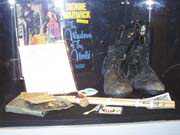A signed baseball. A set of rosary beads. A teddy bear wearing a flak jacket with the inscription “When I die I’ll go to Heaven because I’ve already spent my time in Hell.” A broken piece of a home plate. A set of jump boots.
These are just a few of the objects on display in the Union Hill High School library in Union City. They are part of a travelling exhibit brought to Union City brought by a combined effort of the AmeriCorps and New Jersey Youth Corps organizations. The artifacts are items that have been left at the Vietnam Veterans Memorial Wall in Washington D.C. over the years.
The wall, opened in 1982, stretches for the length of two football fields and contains 58,169 names.
When the wall opened in 1982, it was never expected that anyone would leave anything more than some flowers. According to Gary Patnosh, co-director of the New Jersey Youth Corps, based in Jersey City, at the end of the first day, they had two boxes full of objects that mourners left. The National Park Service was in a quandary as to what to do with the artifacts, as they became Park Service property. As time went by and the number of objects mounted, a warehouse/museum was opened in Washington. At the time of this writing, there are over 70,000 items contained in that warehouse.
These objects include what was on display in Union City.
“I think these objects teach lessons that oftentimes are not covered in books,” said Patnosh.
Spread in vivid detail were artifacts of broken dreams and shattered lives. At the very beginning of the exhibit is a teenager’s bed, complete with sports team pennants on the wall next to it. This part of the display is meant to bring into vivid focus the fact that the average age of the Vietnam War soldier was 19. By comparison, the average age of a World War II combatant was 26.
Groups of 20 or so students at a time were permitted to view the artifacts. And judging by the somber looks and subdued voices of the normally boisterous students, the effect of the exhibit was galvanic.
Said Keith Mandeville, co-director of the Youth Corps in New Jersey, “The exhibit obviously deals with loss and healing. I am finding that people are relating to it in different ways. After September 11, people related to it in terms of that event, and now people are looking at it in terms of the coming war. It shows the cost of what can happen in war and how people deal with it.”
17-year-old Nicole Gonzalez, who is president of Union Hill’s History Club, worked hard to coordinate the exhibit’s appearance at Union Hill.
Said Gonzalez, “I think a lot of people have changed their minds about the coming war. As much good as we’d like to do over there [Iraq], we really have to think about it.” Added Gonzalez, “I encourage people to come see it. It’s so important.”
‘These kids are scared’
According to Union Hill journalism teacher Jack O’ Connor, “[Many students] mask a lot of stuff with jokes, you know, typical teenage behavior. But you know what? These kids are scared, I can tell you. They’re hearing things about a draft and it’s really on their minds.” O’ Connor added that there is a faction of the Union Hill faculty that has a problem with the exhibit. Said O’Connor, “They think there is a [anti-war] slant, a bias, and that it is inappropriate to have in a school.”
It should be pointed out that Union Hill began coordinating this exhibit a year and a half ago, well before hostilities with Iraq came to a head. The display, school officials wanted pointed out, has nothing to do with the current military maneuvering of the United States government against Iraq.
Said English teacher Maria Lanos, “This shows you that these were real people. I think it’s great for the kids. It shows the human side of the war. Seeing the pictures really affected these kids. It connects the past with the present.”
According to student and Youth Corps member Willie Brown, “It’s good. I am glad that people are finding out about history. It’s good to know about this stuff.”
In one of the cases is a handwritten letter and a pair of drumsticks left at the wall. The letter, written by a Navy man named Joe Anthony from Hawthorne, N.J., states, “To pay my last respects to you, I give my National Defense Medal and white-draped drumsticks. Take these drumsticks to beat the drum softly and serve as a reminder to all of your ultimate sacrifice. So sleep gently now, my brothers and sisters, and you will not be forgotten.”
